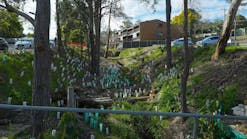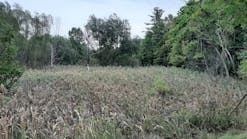In their simplest form, gabions are essentially rock-filled wire baskets or cages-the word gabion is derived from the Italian gabbione, meaning “big cage.” Similar structures date back thousands of years to the time of the pharaohs in Egypt. It seems the Egyptians filled baskets of woven reeds and placed them along the banks of the Nile River for protection against erosion.
Today’s gabions come in multiple forms. The wire shell may be untreated or galvanized, uncoated or PVC coated. A gabion may be a standalone unit or joined with others to produce a large, interlocking structure.
Gabions are useful for a number of applications. Similar to a retaining wall, they can be used for slope stabilization; can protect culverts, streambanks, and other channels against high-velocity moving water; and can even be formed into a variety of aesthetically pleasing structures. Gabion mattresses, with a small height relative to their lateral dimensions, may be used to line channel bottoms, for levee revetment, and for scour protection. Vertical diaphragms are often affixed to the base of gabion baskets to provide additional reinforcement and to limit internal movement of the rock filling.
Gabion baskets are typically preferred over loose riprap because gabions are a much more visually attractive option. They also offer a significant advantage over poured concrete and other rigid structures because they conform to ground contours, accommodate movement, and dissipate energy while draining freely. With rigid hard-armor treatments, catastrophic failure can occur with even small foundation movement.
They tend to be less expensive than most other construction materials, and the fill rock can often be found onsite. They form a natural drainage system, minimizing the buildup of hydrostatic pressure that could damage other structures or streambanks. Silt and vegetation can quickly fill the interstitial spaces in the rock fill, adding strength and attractiveness to the finished product. When completed, gabion structures are virtually maintenance free. If desired, they can be covered with soil and vegetation for an improved appearance.
Houston Amphitheater
While most gabion applications serve as retaining walls or as streambank protection, a recent project in Texas was a bit different. Grant Detro of Modular Gabion Systems, a division of C.E. Shepherd Co., with offices in Houston, TX, and Mobile, AL, describes it as an “architectural application around an amphitheater at a local Houston park.”
For this project at the Gene Green Beltway 8 Sports Park, Detro’s company produced the following unusual structures:
- Amphitheater seating in which a long, flat surface was applied to the tops of rows of connected gabion baskets
- A gabion bioswale to protect a bit of green space in the parking lot
- Gabion benches, essentially smaller versions of the amphitheater seating
- A pedestrian traffic barrier much like the amphitheater seating, with a long, flat surface on top of a long row of gabion baskets
- Large gabion structures in the amphitheater itself, for decoration and for sound abatement
“This is a largely unique application,” Detro explains. “We have had our gabions used for benches in another park and as pedestrian traffic channelizing devices. In some installations they double as small retention structures as well.”
For this project, Detro adds, the gabion baskets were the only option considered. “Gabions have been used throughout the world to create fascinating architectural elements and even structures, although their use as such in the United States has been very sparse. It is my understanding that the architect on this project had desired to use gabions in this manner from the onset of the project.”
Recycled concrete was used for fill material for the gabions, in the absence of a sufficient local rock source. “It looks good and makes the project a little more “˜green,'” according to Detro. There were no access or regulatory difficulties encountered, but the custom mesh for the baskets did require a little more lead-time. In the end, both the architect and the contractor were quite pleased at the appearance of the finished project.
The response of the local community has been equally enthusiastic. “The park has been a great success,” Detro says. “The only issue that was encountered with the gabion structures was that some of the rock fill in the bioswales was smaller than the mesh, and it was discovered that some of the sports park visitors were picking these small rocks out of the gabions. The remedy for this was to insert a small mesh-half-inch by half-inch in about 20-gauge wire-behind the gabion mesh to prevent this.”
Asked if there were any plans to vegetate these gabions, Detro says, “For this particular project, no. The gabion mesh was a custom product and was chosen to be aesthetically pleasing. The gabion structures utilized a 2-by-4-inch, 9-gauge PVC-coated mesh for the baskets. The size of this mesh has created some very good-looking gabions, which was the intention, and currently there is no intention to vegetate.”
He adds that since the completion of this amphitheater project in late 2008, his firm receives inquiries nearly every week about similar projects.
New Jersey Spillway
From the concrete dam at one edge of Upper Erskine Lake in New Jersey, water is carried via a spillway to reach two large pipes, which then direct the water to the lower lake on the other side of a roadway. By August 2008, the spillway had deteriorated to the point that 400 linear feet had to be rebuilt.
“The original design of the project called for the use of 12-by-6-by-1-foot Reno mattresses,” says Richie Prejs, area manager for Maccaferri in New Jersey. “But when I saw the 400-foot length of the spillway, I recommended using the 99-by-6-by-1-foot gabion mats, our rolled product. The Reno mattress comes in flattened bundles. The gabion mats, when they come to the project, look like rolled chain-link fence. It’s just easier for the contractor, especially on the long runs. Instead of assembling 20 Reno mattresses, you’re rolling out one mat to cover the same area.”
In addition to easier setup, the rolled gabion product can be applied more quickly and economically than individual units. The gabion top also comes as a single-piece rolled unit.
The gabion mats, at 99 feet long, 6 feet wide, and 1 foot high, are one of Maccaferri’s standard products. A 60-foot-long mat is also standard, but Prejs notes that the company can manufacture any length needed for a project. For this effort, he also used his company’s geotextile filter fabric MacTex MX275, a nonwoven fabric, applied underneath the gabion mats. The geotextile fabric acts as a separation and filtration layer and limits the washout of fine particles from beneath the gabion mat in the presence of high-velocity water flows.
He adds that he did retain the use of Reno mattresses (essentially flatter, folded gabion baskets) for part of the project. “Coming off the concrete portion of the spillway, I used four or five Reno mattresses just to fill in that end. We custom-cut those, and then we were able to have the mats run right up to the edge. The whole project used 16 of the 99-by-6-by-1 gabion mats. The spillway was 400 feet long and 24 feet wide-thus the need for 16 of the gabion mats.”
The project, which was completed in March 2009, didn’t encounter any regulatory issues. The main design change was the substitution of gabion mats for Reno mattresses for the primary portion of the project, but Prejs notes, “We got the technical data sheets to the engineers, and they approved it right away.”
Access wasn’t a major problem, but there was one small area that proved a bit challenging. “There was one portion where the poured concrete structure leads to the gabion spillway,” he explains. “It was a little tight in there, so what the contractor did was to leave a little gap to one side, on the right, where they left a mat out. They completed the mats on the left hand side, then where the void was, rolled a mat in a little, installed a little, and rolled it out a bit more, just to get away from the low height. Once we got past a certain point, we rolled them all out and we were able to fill up over the side.”
Prejs notes that although he has used gabion mats successfully in many landfills, this was his first spillway gabion project.
Lake Michigan Bluff Repair
Apparently because of an underground water leak from a city service, a private residence resting on a wooded bluff above Lake Michigan had a major washout of the bluff between the house and the lake. The soil on the bluff consists of a sand layer resting on top of a hard clay layer. The slope washout took with it many of the home’s mature trees and seriously threatened the foundations of the house.
The homeowner needed a solution that could be implemented immediately. It would have to be installed from the beach to protect the home and garage foundations, but it also should provide an aesthetically pleasing structure on the tight property line.
The proposed solution, suggested by Benchmark Engineering of Harbor Springs, MI, called for the construction of a retaining wall to stabilize the slope and prevent further erosion.
“Access to the site was limited, so we had to bring in something in pieces,” says project engineer Joe O’Neill. “All the material-stone for backfill, blocks, and equipment-had to be moved about 1,000 feet down the beach with a loader. The installer had to obtain special permits from the Department of Environmental Quality to track across the beach. Installation could be completed only from the front of the wall.”
For the project, Benchmark specified Redi-Rock retaining walls in two 12-foot tiers with 8 feet between the two. The design of the wall called for two 90-degree outside corners using Redi-Rock’s 9-inch-setback block to allow for adequate backfill behind the wall while requiring minimum excavation. There was approximately a 26-degree batter angle to the wall, and Redi-Rock 41-inch anchor blocks were used for the first course of both tiers of the wall.
Jack Bergman of Redi-Rock explains that these anchor blocks are basically standard Redi-Rock blocks measuring 46 inches wide, 18 inches high, and 41 inches from front to back. The difference with an anchor block, he says, is that “You have a 10-inch-square hole in the middle of the block, with a slot coming out the end so you can bring the rod in. All that’s unique to the block is that we make our connection with a threaded rod-that’s what most anchors are, just a threaded rod-and the anchors are on the end of it. They have to be far enough back to provide the anchoring.”
Done properly, the anchor is intended to be a permanent fix. “Things can happen, though, if you don’t put the anchor in far enough,” says Bergman. “But assuming it’s put in correctly, it’s anchored in the soil. You have to realize that it’s an active zone. It’ll go sliding down the hill if you have a failure. In order to have proper anchorage, you have to be outside of that [zone]. If your anchor only goes into the part that’s sliding down the hill, it will all go down the hill. But if it’s anchored beyond that failure plane, in the native soil, then it’s providing anchorage. It has to be designed to be the appropriate depth-it’s a function of the height of the wall, the type of the soil, and so on.”
In this case, Manta Ray MR-1 galvanized soil anchors were used, extending a minimum of 18 feet into the soil behind the wall at a downward angle of 12 degrees. Additionally, a 10-foot length of geogrid was installed between the fifth and sixth courses for additional stability.
In addition to being able to be constructed without significant excavation, the Redi-Rock retaining wall was selected for its appearance. As Bergman explains, “There are people who at times will put in ugly riprap-type stuff if they’re allowed to. Sometimes they’ll use sheet piles, and gabions can also be used. But this is a high-end house, and they wanted a nice appearance.” The retaining wall also provided ample room for the homeowner to replace the landscaping that was lost due to erosion. In total, about 1,850 square feet of retaining wall was constructed.
Bergman notes another important reason for a strong wall with permanent anchoring: “The house is sitting on a hill close to the water, and the hill was eroding away from the wave action of the lake. It’s normally a fair distance from the water, but when the water is high or you get big waves, it gets to the bottom of the dunes, and their house was built on top of the dunes.” Water levels in Lake Michigan can vary by a number of feet, depending on regular lake cycles.
“It’s not like a tide,” he continues. “We’re talking years. It could be a 10-year cycle-it goes up and goes down. There’s the outflow from Lake Superior into it, and rainfall in the whole basin. There’s normally a beach there, fairly wide. But when the lake is at its higher levels, then you get waves that are 3 or 4 or 5 feet high on the lake. That’s why the dunes are there; they are nature’s prevention for all that stuff. When the water reaches the toe of these dunes, then it starts attacking them.”
Interestingly, similar strong retaining walls may not necessarily be needed for nearby properties. “Everything changes as you go along the beach,” he says. “But normally, people don’t build too close to the water.”
It’s All About Orientation
Alongside interstate I-90 just north of Rockford, IL, sits a small drainage channel that would often fill with water, causing significant erosion. The Illinois State Toll Highway Authority hired engineering firm V3 Consultants to design a solution. The contractor and installer was Dunn Rite Landscaping.
The decision was made to use articulated concrete blocks as the main weapon against erosion for this project, but an interesting problem arose in the process.
Doug Buch of Submar Inc. provides some background: “One of the problems that we often come across-and I’ve been doing this for about 15 years-occurs when engineering firms try to do what is called a mat layout. The individual concrete blocks get fabricated into mats, and the layout or dimensions of the mat are laid out by the supplier. That layout is done according to several things, one being site access. With the big mats, can you get in there? If it’s a tough site, you may have to use small mats. Another site like this one might be wide open, where you can get large mats in. The size of the mats was not the problem on this project. The other issue is the equipment. What equipment does the contractor have at its disposal? That is how suppliers can size the mats, so it can suit the contractor’s equipment.”
So what was the problem in this case? “What happened on this one was that the engineering firm laid out the mats and called out the mat sizes,” Buch says. “The problem was the mat sizes that were called out. For example, an 8-foot-wide by 5-foot-long mat is different from a 5-foot-wide by 8-foot-long mat. They’re both 40 square feet, but the problem when you’re using concrete mats is that cables stick out of the ends. When cable loops meet up against one another, that gap is historically grouted. If you’re going over a thousand linear feet, and every 5 feet you have a grout joint; that adds up. That adds a significant cost to the contractor. It’s all about the orientation. So what we did was to orient it differently from what the firm had, and it threw everybody out of whack.”
“That wasn’t what we had drawn up,” the engineers told Buch, but they ultimately went along with the changes. The solution didn’t cost anybody anything, he notes. “At the end of the day, the square footage supplied was the same. The dimensions of the mats were the same. It’s just that the orientation of the mat allowed for no grouting, which made the project look a lot nicer. Instead of a grout joint every 5 feet, there are grout joints only on the turns. It made for a much, much easier installation for the contractor.”
Buch adds, “Engineering firms don’t do this on a day-to-day basis; suppliers like us, Submar, we do. This is what we do. So we try to beg and push the engineering firms to just save themselves some work. Just call out the hatch pattern where you want the blocks to go and let the experts, the people who do it every day, provide the mat layout.”
One engineer remarked to Buch that it appeared his firm’s design would require more mats, but Buch explained that the same square footage was still being used. “It was all the same,” he says, “but the orientation made a big difference. Who we helped the most on the whole thing was the owner and the contractor. The contractor got a much easier install, and the owner got a much better end product. And the only thing it cost was some time.”
He explains why articulated concrete blocks were selected for this project. “The Illinois State Toll Highway Authority, up until about 1998, used exclusively grout-filled pump mats. After 1998, they became more and more interested in vegetating their channels. One of the big drawbacks to grout-filled mats is they don’t vegetate. The toll authority wanted to green up the tollway as much as they could and to look for vegetated options. Realizing they couldn’t just go to pure grass, or even a turf reinforcement mat, because of the velocities that they were receiving on some of their channels, they began to use an open-cell articulated concrete block. These open-cell articulated concrete blocks have been the product of choice for erosion protection in channelways for the toll authority since the late 1990s or early 2000s. The reason? It’s all about green-getting vegetation, getting green. Then the Illinois Department of Transportation started following suit. The two agencies work with each other, and employees transfer back and forth, and now we’re seeing a lot more vegetation. In addition to looking better, maintenance is much easier. Once you get vegetation established on these things, you can drive on it, mow it, and maintain it.”
Although the articulated concrete blocks formed the core of the solution for this channel, they weren’t the only treatment. “The other thing used was a rolled erosion control blanket. Here’s why they do it this way-everything has a place in the toolbox,” Buch notes. “What the engineering firm did was very smart. They put the blocks in where they’re going to have the majority of the water flowing, but to the sides of that, they went to a much cheaper, much more economical rolled erosion control product.”
Other potential solutions had their drawbacks. “Where the water is going to be continuously flowing, you can’t really put an erosion control blanket down there because it’s just going to degrade. And nobody wants concrete down here because of the freeze-thaw cycle causing busting up and cracking. The big advantage to articulated concrete blocks over concrete is that we already have our cracks built into the system-the blocks move. As the ground settles and things move around, the blocks move with it. It’s a very forgiving system. It’s ideal for these types of applications. You’re probably going to pay a little more than you would for rock, but as soon as you have to come back and re-do the rock, add more in, move it around, then you’re paying more for it.”






